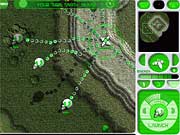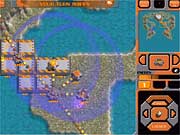MoonBase Commander is a budget-priced game whose almost nonexistent advertising positions it somewhere between a cute product for young kids and a strategy game for dummies. It's hard to imagine a marketing campaign more likely to ensure that MoonBase Commander is ignored by virtually everyone. That's a shame, because it's one of the most accessible and uniquely addictive strategy games this year.

At its core, MoonBase Commander is a turn-based wargame. However, it also combines the base building, resource management, and heightened pace of a real-time strategy game with the aiming and precise positioning mechanics of a puzzle shooter such as Bust-A-Move. It's an unusual combination that the developers at Humongous Entertainment managed to pull off with aplomb.
Each player starts with a single hub. Drawing points from an energy reserve, hubs can create any of the game's 18 units, including new hubs. These 18 units are split into three groups of six, and each group involves a different production cost. Most of the units are either one-shot weapons or stationary buildings. All the units are launched from a hub by first indicating the direction for the launch and then setting the force of the launch using a power meter like the one usually used in golf games. After being launched, permanent units are tethered by a cord to the hub that created them. Since these cords can't cross each other, a single hub can accommodate only eight structures. When a hub is destroyed, any unit created by that hub is destroyed as well, meaning that the destruction of the initial hub results in a hugely satisfying chain reaction that levels a player's entire base, knocking him or her out of the game.
Each turn, players alternate launching a single unit. When you're out of energy, you're done for the round. When all players are out of energy, the round ends and everyone's energy pool is replenished with bonuses added for each energy collection structure you have. You can also opt out of a round early, in which case any remaining energy in your pool carries over into the next round. The last surviving player wins the game.
With only 18 items to build, no tech tree, and no individually controllable units other than the launching capability of hubs, MoonBase Commander might appear to be too simple to work. But through a small miracle of tight design, boy, does it work. The 18 units are strongly differentiated, and they're all useful. Many of them can be utilized in multiple and surprising ways. For instance, the energy collector is primarily a utility structure that provides extra energy each round. However, when destroyed, it's also the most powerful explosive in the game. Landing an energy collector near enemy equipment and then blowing it up yourself is a great offensive tactic.
The lack of a tech tree eliminates most of the initial build-up grind common to real-time strategy games. Players are able to build meaningful units and start scouting for the enemy right away. It also helps keep games from becoming completely one-sided. You'll never be stuck in the Stone Age while your opponent is flying around in rocket ships. As long as you have your initial hub, you're still in the game.

The create-one-item alternating turn structure, combined with the lack of mobile, directly controllable units, eliminates the other scourge of production games: the rush. You might even say that MoonBase Commander is the ultimate base-building game--the only way to win is to place your structures carefully and expand into enemy territory. The game's turn structure also eliminates the tedium often associated with playing turn-based games in multiplayer, since you never have to wait very long to make a move. You can even set a clock to force players to take their turns quickly.
MoonBase Commander's 2D graphics aren't exactly state of the art, but they're clean and colorful without being too cutesy. There are four different teams in the game. Though each one has the same units, they all have different graphics, HUDs, and voice samples accompanying various actions. The acting is top-notch--the Japanese-sounding robot girl who provides color commentary for one of the sides is especially good.
The game has two single-player modes. In challenge mode, you play through 16 battles of escalating difficulty. There's also a skirmish mode that lets you set up games on any of 47 maps against up to three computer-controlled players. There are 10 different AI opponents available, and the toughest ones are legitimately hard to beat.
From the standpoint of playing the game, MoonBase Commander's multiplayer mode is its strongest point. Unfortunately, from an interface perspective, it's also its weakest feature. No built-in server browser is available, which is annoying, though you can find games using third-party utilities, and there's apparently a fan-created direct IP link-up feature available as well. Although you can set up two-on-two team matches, the undocumented team chat feature is somewhat cumbersome to use, making secret communications with your partner difficult. On the bright side, MoonBase Commander can be played in a window (a feature that should be standard in all turn-based games), so you and your teammate can chat using any instant messaging program.
There's a fine line between elegant and merely simple. Contrary to what you might expect of it, MoonBase Commander falls squarely into the elegant category. It's lean, fast-paced, and surprisingly deep. Infogrames' official site calls it "the strategy game for everyone," and for once you can believe the company line. It's hard to imagine anyone not enjoying MoonBase Commander.